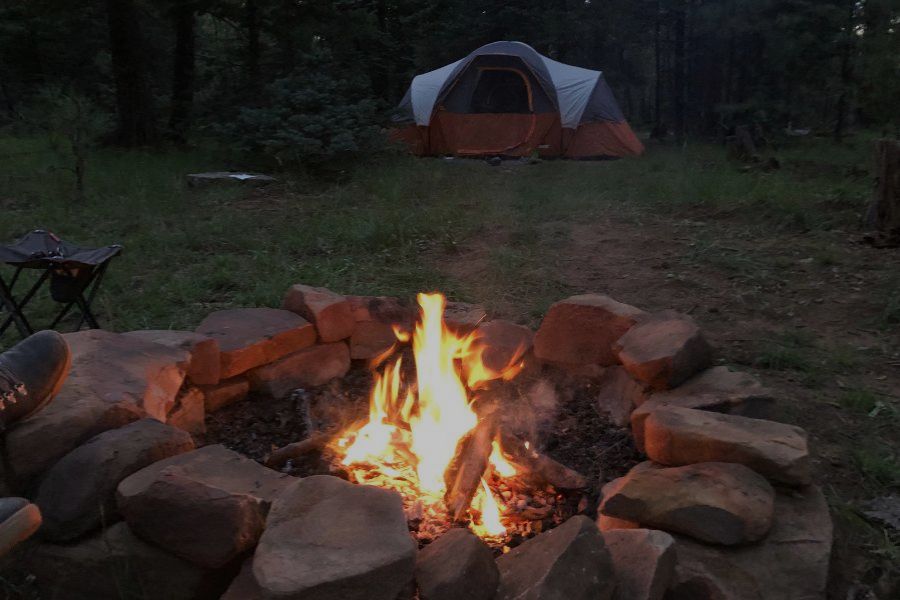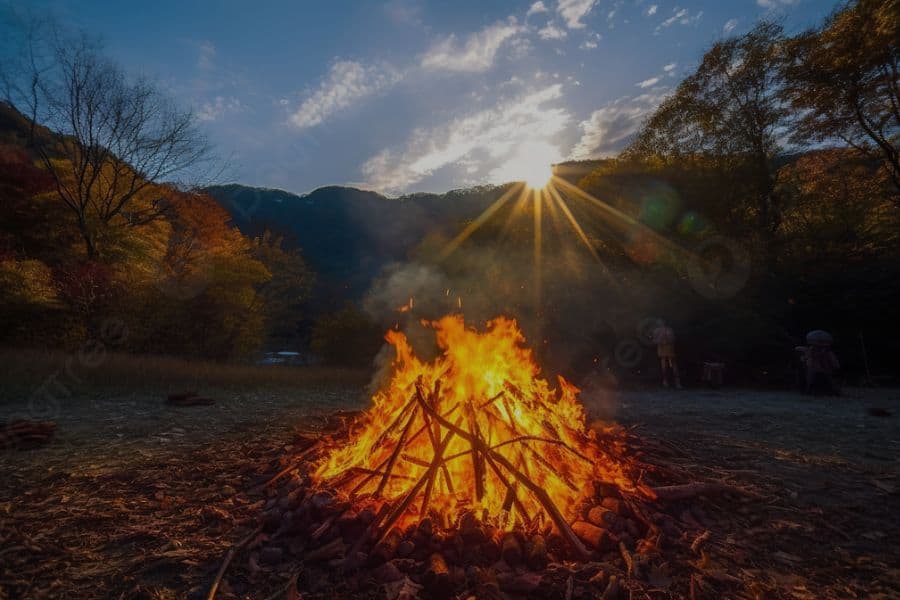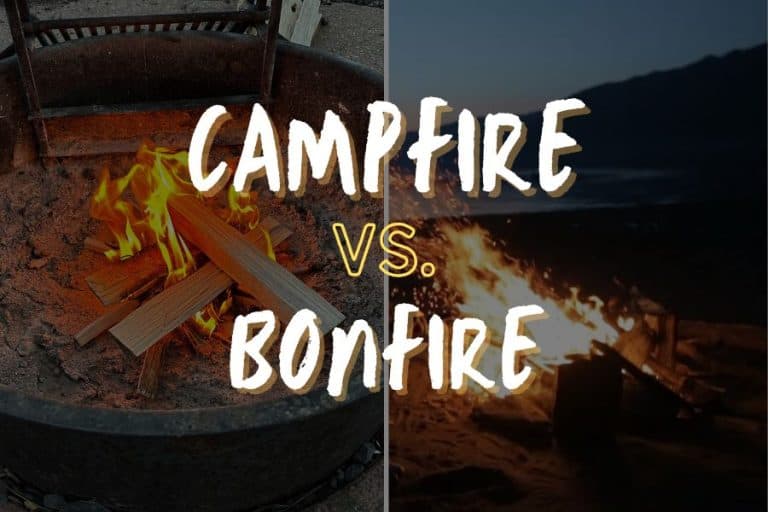I’m sure you’ve heard people using these two terms to address a controlled ring of fire. But while they are often used interchangeably, they’re definitely not the same.
What’s the difference, you might ask?
In this article, I’ll share with you everything you need to know about both types of fire, from appearance to purpose.
Let’s dive straight in!
Table of Contents
ToggleBonfire vs Campfire – How to Tell Them Apart
Let’s start with some campfire basics…
What is a campfire?

As the name suggests, a campfire is a type of fire built at campsites. A campfire is small in size and contained within a fire ring or pit.
It’s a staple of every camping spot, as much as a tent. When the sun goes down, a campfire becomes the central point people gather around to eat, warm up and socialize. They can also help you repel mosquitos and other insects, as well as keep the wildlife away.
What is a bonfire?

In a way, we can say that a bonfire is basically a campfire on steroids. It’s a controlled outdoor ring of fire, but in terms of size, it’s gigantic compared to a campfire.
Aside from the size, these two types of fire have different purposes. While campfires are usually used for cooking, bonfires have been mostly built for celebrations, a tradition that dates back to ancient times.
A bonfire has been a staple in Celtic tradition, lit for different occasions, such as Midsummer’s day and Samhain. The Celts believed the flames can keep the evil spirits away and bring good fortune to their crops.
While the spiritual purpose may have declined in time, bonfires are still a staple piece of outdoor celebrations.
Because of their size, bonfires are built in open spaces like fields and meadows, far away from any trees or bushes.
Large flames create intense heat, so it’s important that there’s nothing in the surroundings the sparks can spread onto. For the same reason, people usually stand back rather than sit around it.
The intense heat also makes the bonfire unsuitable for cooking. Just try roasting marshmallows on it – it will become pitch black within a minute or less.
Building a Bonfire
A bonfire should only be built in an open area without trees, dry grass or other flammable materials close by.
Sometimes, it only takes a spark for fire to spread, so it’s important to make it as far as possible from anything that can easily burst into flames.
Building a bonfire starts with the foundation. The best way to contain a bonfire is to mark the area with bricks or stones and dig a pit inside of it.
As for starting the flames, the process is similar to other types of fire – you need a fire starter, tinder and kindling. But feeding the bonfire will require much more fuelwood. You can use branches and logs, but other dry wood will work as well.
But don’t use driftwood, because it releases harmful chemicals when burned.
In fact, people often make bonfires to get rid of old furniture and other wooden stuff like palettes, chairs or even doors. As long as it’s not coated with paint, you can use pretty much anything made of wood.
There’s one thing to keep in mind. Depending on your location, you might need to obtain permission from local authorities before building a bonfire.
During the summer months, fires can be prohibited altogether in certain areas with a really hot climate.
It goes without saying that bonfires should never be left unattended.
Before you leave, make sure to dose it with enough water to extinguish the flames. Pour water in several doses onto the bonfire, while mixing ambers at the same time. You’re not done until the embers are cool to the touch.
Building a Campfire
In a way, a campfire is a bonfire in miniature. You need to build a fire ring or pit away from branches, greenery and other materials that can easily catch on flame.
Many campgrounds have pre-built rings for you to use, but if there isn’t one, you can easily make it with rocks found nearby.
To make it functional, a fire ring should be at least two feet wide in diameter. You should also dig a hole that’s at least a few inches deep.
To start a campfire, you need both tinder and kindling. These types of wood are dry and easy to light up. You can also use pieces of cardboard and wood shavings in addition. Once you get a nice flame, you can start adding larger pieces of wood.
Just keep in mind that not all wood is suitable for making fire. You may also need to split wood with a hatchet or axe into smaller sizes.
Green firewood pops, sizzles and makes a large black smoke. Basically, it does everything except what you wanted it to do.
Choose a space that is clear and away from trees, brush, and tents.
Green firewood isn’t a specific species of tree. The term is used to identify any type of wood that’s high in moisture and unseasoned.
Proper firewood needs time to age and dry out enough to be able to create a flame. The exact aging period depends on the species, but in most cases, it takes about a year or so.
When you are ready to go to sleep or leave the campfire, it must be completely extinguished.
You should have a bucket with you or find something that can carry water. Drown the campfire completely. You need to use a stick to mix the embers and ashes with the dampened soil.
Whether you’re going to sleep or leaving the campsite, it’s equally important to put out the fire before leaving.
Drown the campfire in water, then mix ashes and embers. Do this until the pit is cold to the touch.
Last but not the least, remember to leave no trace. This means packing everything, including what’s left after you extinguish the campfire.
Also see: How to Cook Over a Fire (Pro Campfire Cooking Tips)
Bonfire vs. Campfire – Compared
If you’re anything like me, then you probably find it much easier to understand the difference by making a table and comparing the difference. In this section, I’ll list the characteristics of each fire type side by side for better understanding.
CAMPFIRE | BONFIRE | |
Size | Small | Large |
Used For | Cooking and Providing Warmth | Large Celebrations |
Permission | May require permission during wildfire seasons | Usually requires permission from local authorities |
Fuel | Branches and Wood Logs | Disposed Wooden Materials and Large Logs |
Place | Built in open space away from flammable materials | Built in wide open spaces, such as meadows and beaches |
FAQ
I’m sure you have tons of questions regarding these two types of fire. In this section, I’ll try my best to give you brief but comprehensive answers to some things you might be wondering about.
How hot does a bonfire get?
A lot of things affect how hot a fire can get, including the type of fuel you’re using as well as the size of the fire.
One visible indicator you can rely on when figuring out how hot a bonfire is is the flame color.
Blue flames are the hottest ones, and they appear when the fire reaches temperatures between 2,600°F and 3,000°F.
But in most cases, you’ll see red flames, which indicate that the temperature is about 1,100°F to 1,650°F. But watch out, because that’s still hot enough to melt some types of metal!
What is the difference between a bonfire and a campfire?
The main difference, and the one that really sets them apart is the size. A campfire is usually up to a few feet in diameter, while a bonfire is much larger.
All other differences between the two types of fire are derived from that one. Because they’re large, bonfires are usually much hotter than their smaller alternatives. This makes them suitable for large gatherings, as you don’t have to sit close to them to feel warm.
On the other hand, this makes them unsuitable for cooking. In most cases, the flames are so hot that they’ll turn your food into coal within a minute.
What makes a fire a bonfire?
Because they’re large in size, but also because they’re built in open spaces, bonfires are pretty easily distinguished from other types of fire. You can see the flames reaching high up in the sky.
They’re definitely appealing to watch, which makes it somewhat obvious how they were used for ritualistic purposes since ancient times.
What do you call a small bonfire?
Some might say that a campfire is a small bonfire, and they wouldn’t be wrong. After all, the main difference between them is the size.
But because they have different purposes, it would be more linguistically appropriate to simply call it what it is – a small bonfire. Now, that doesn’t mean you can’t name it any way you want.
What are bonfires used for?
While bonfires have a long history of religious and ritualistic purposes, nowadays they’re most commonly used for keeping a large group of people warm.
Which is hotter – a campfire or a bonfire?
A lot of things affect how hot a fire can get, including the type of fuel and flow of oxygen.
But most importantly – the size of the fire. More fuel means that a bonfire is definitely hotter than a campfire.
What is better to cook on – a campfire or a bonfire?
Bonfires are not suitable for cooking because the flames can get too hot. If it sears down a whole wooden chair in just a few minutes, what do you think it will do to your steak?
If you want to cook food while outdoors, you need to build a campfire. Just keep in mind that it won’t work exactly the same as your stove at home.
If you’re not careful, a campfire can also sear your food and even completely burn it.
Bonfire and Campfire Safety Concerns
Before you start “playing with fire,” there are a few things you need to know regarding fire safety.
First on the list is the red flag warning. The National Weather Service sends out a warning when the weather conditions are likely to cause a wildfire to spread.
About 90% of wildfires in the US are caused by human negligence, such as leaving it unattended or not properly extinguishing it.
You should pay attention to dry air as well. As you know, fire and water don’t go hand in hand. Humidity in air and condensation on surrounding objects can make them less ignitable. But when the moisture in the air drops, fires are much easier to spread around.
And finally, never start a fire in high winds. It can only take a single airborne spark to start a wildfire with disastrous proportions.
In Conclusion
While both campfire and bonfire provide warmth, they’re usually built with different purposes in mind.
Campfires are small and used for cooking and gathering at the campsite at night.
Bonfires, on the other hand, are usually built to keep a large crowd of people warm. While they were originally used for ritualistic ceremonies, today they’re a staple of beach parties and similar gatherings.
Next up: How Much Firewood Do I Need For Camping? – And Where To Buy It


